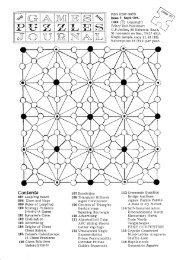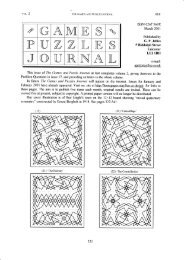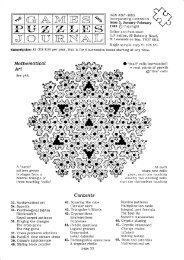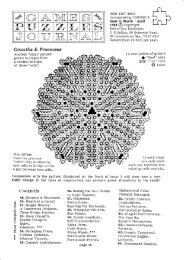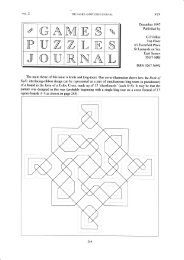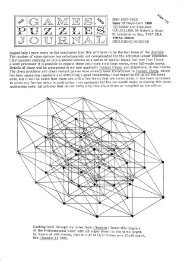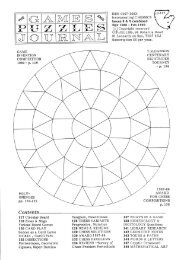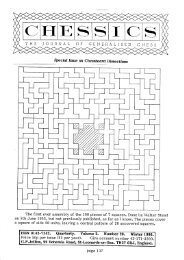The Games and Puzzles Journal, #5+6 - Mayhematics
The Games and Puzzles Journal, #5+6 - Mayhematics
The Games and Puzzles Journal, #5+6 - Mayhematics
You also want an ePaper? Increase the reach of your titles
YUMPU automatically turns print PDFs into web optimized ePapers that Google loves.
"s<br />
THE GAMES AND PUZZLES JOURNAL<br />
$" ^$ THE NIM FAMILY OF GAMES<br />
<strong>The</strong> name Nim comes from an Old English word-meaningrtaket, from which we also<br />
get the word himbler meaning 'quick in movement or in mental apprehension'. It is applied<br />
to a whole family of games, mostly played by the taking of counters with the object<br />
of being the player who takes the last one. <strong>The</strong>re are always two players <strong>and</strong> every<br />
position is either winning or losing for the player whose turn it is to go. <strong>The</strong>re are no<br />
ties. Each such game has a tmisere' variant in which the aim is to avoid taking the last<br />
counter, but the strategy is usually Just a slight modification of that for the tdirect'game"<br />
Battle of Numberc<br />
<strong>The</strong> earliest account of a Nim-type game that I know of is the Battle of Numbers<br />
described in the of C.G.Bachet, pubffi<br />
playerstaketurnhtimeaddingonanttmberfromoneupto<br />
a specified limit, t (say 6), <strong>and</strong> the winner being the first to reach a finishing total, T (say<br />
100). <strong>The</strong> numbers to try to leave your opponent are T - m(t+l), that is, 2, 9, 16, 23, 30'<br />
97, 44r 51, 58, 651 72, ?9, 86, 93 in the example. When played with counters, 100 are placed<br />
in'a heap'<strong>and</strong> up to t are taken each time <strong>and</strong> you must aim to leave a multiple of t+1.<br />
<strong>The</strong>n if your opponent takes s you take (t+1) - s of eourse.<br />
<strong>The</strong> play in Cribbage, which was invented around 1640, uses the same principler with<br />
3L as the target tot6tt-Lt the choice of numbers to be added is restricted to those on the<br />
cards in your [<strong>and</strong>, <strong>and</strong> the other Cribbage characteristics dominate the Nim aspect.<br />
Nim<br />
<strong>The</strong> quintessential Nim however dispenses with the numerical limit, t, by arranging<br />
the counters in several heaps. <strong>The</strong> only rule then is that a player must take one or more<br />
counters, all from the same heap. Thus if there is Just one heap; the player to go can<br />
win by scooping the lot, <strong>and</strong> if there are two heaps he can win if he can equalise the<br />
two. With more heaps the strategy is not so obvious, it was first explained in 1902 by<br />
C.L.Bouton in the Annal's of Mathematics. He showed that the player to go can win<br />
ifhecanleven-up'@thatthenumbersof1s,2S,4s,8s,16s,etc<br />
(i.e. powers of two) in the heaps total to even numbers. For example, if there are six<br />
heaps containing I, 2, 3, 4, 5, 6 pieces then there are 1+2+3+d+$+$=!l ones in it, <strong>and</strong><br />
0+I+L+2+2+3=9 1wos, <strong>and</strong> 0+0+0+1+1+1=3 fours. Thus the player must 'remover a one<br />
a two <strong>and</strong> a four to even up. This he can do by removing one counter from heap 4.<br />
NrmmitY<br />
I have coined the name Nimrqlly (Greek 'mitosr = thread) to apply to a range of Nim<br />
type games in which the rule-fpGy is to take one counter or else a group of eounters<br />
in unbroken sequence along certain lines. [Regulation: <strong>The</strong> who]e take must be made in<br />
one motion, the removal of your h<strong>and</strong> from the layout signifying the end of your go' after<br />
which you may not return to take some more, nor to replace any.i This is a very fruitful<br />
concepi, leading to an enormous variety of possible new forms of Nim play. Here beginneth<br />
a nimiety of nimmities! For example:<br />
Rank <strong>and</strong> File. <strong>The</strong> counters are arranged in a square array (e.g. on a chessboard).<br />
fne flETllayer rnay only take groups that lie along the ranks, <strong>and</strong> the second player<br />
only along the files. By taking a group that crosses both main diagonals the first player<br />
can thus prevent the second making a take that will leave a symmetric position.<br />
Black Spot. <strong>The</strong> array is a hexagonal honeycomb formation with a black counter<br />
on the centre point. <strong>The</strong> lines are closed paths without crosslinks (e.g. three counters<br />
each touching the other, or six counters surrounding another). Onty complete circlets<br />
can be taken, not single counters or open paths. <strong>The</strong> black counter must always form<br />
part of at least one circlet. <strong>The</strong> object is to force your opponent to take the black spot<br />
(because it is part of the last circlet to be taken).<br />
page 66




